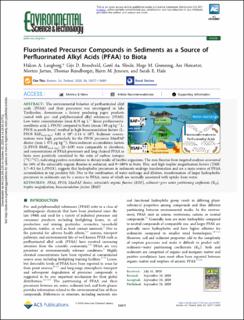| dc.contributor.author | Langberg, Håkon Austad | |
| dc.contributor.author | Breedveld, Gijs D. | |
| dc.contributor.author | Slinde, Gøril Aasen | |
| dc.contributor.author | Grønning, Hege Mentzoni | |
| dc.contributor.author | Høisæter, Åse | |
| dc.contributor.author | Jartun, Morten | |
| dc.contributor.author | Rundberget, Thomas | |
| dc.contributor.author | Jenssen, Bjørn Munro | |
| dc.contributor.author | Hale, Sarah | |
| dc.date.accessioned | 2020-10-23T09:38:49Z | |
| dc.date.available | 2020-10-23T09:38:49Z | |
| dc.date.created | 2020-10-20T18:04:48Z | |
| dc.date.issued | 2020 | |
| dc.identifier.citation | Environmental Science and Technology. 2020, 54 (20), 13077-13089. | en_US |
| dc.identifier.issn | 0013-936X | |
| dc.identifier.uri | https://hdl.handle.net/11250/2684714 | |
| dc.description.abstract | The environmental behavior of perfluorinated alkyl acids (PFAA) and their precursors was investigated in lake Tyrifjorden, downstream a factory producing paper products coated with per- and polyfluorinated alkyl substances (PFAS). Low water concentrations (max 0.18 ng L–1 linear perfluorooctanesulfonic acid, L-PFOS) compared to biota (mean 149 μg kg–1 L-PFOS in perch livers) resulted in high bioaccumulation factors (L-PFOS BAFPerch liver: 8.05 × 105–5.14 × 106). Sediment concentrations were high, particularly for the PFOS precursor SAmPAP diester (max 1 872 μg kg–1). Biota-sediment accumulation factors (L-PFOS BSAFPerch liver: 22–559) were comparable to elsewhere, and concentrations of PFAA precursors and long chained PFAA in biota were positively correlated to the ratio of carbon isotopes (13C/12C), indicating positive correlations to dietary intake of benthic organisms. The sum fluorine from targeted analyses accounted for 54% of the extractable organic fluorine in sediment, and 9–108% in biota. This, and high trophic magnification factors (TMF, 3.7–9.3 for L-PFOS), suggests that hydrophobic precursors in sediments undergo transformation and are a main source of PFAA accumulation in top predator fish. Due to the combination of water exchange and dilution, transformation of larger hydrophobic precursors in sediments can be a source to PFAA, some of which are normally associated with uptake from water. | en_US |
| dc.language.iso | eng | en_US |
| dc.publisher | American Chemical Society | en_US |
| dc.rights | Navngivelse 4.0 Internasjonal | * |
| dc.rights.uri | http://creativecommons.org/licenses/by/4.0/deed.no | * |
| dc.title | Fluorinated Precursor Compounds in Sediments as a Source of Perfluorinated Alkyl Acids (PFAA) to Biota | en_US |
| dc.type | Peer reviewed | en_US |
| dc.type | Journal article | en_US |
| dc.description.version | publishedVersion | en_US |
| dc.rights.holder | © 2020 American Chemical Society | en_US |
| dc.source.pagenumber | 13077-13089 | en_US |
| dc.source.volume | 54 | en_US |
| dc.source.journal | Environmental Science and Technology | en_US |
| dc.source.issue | 20 | en_US |
| dc.identifier.doi | 10.1021/acs.est.0c04587 | |
| dc.identifier.cristin | 1840985 | |
| dc.relation.project | Norges forskningsråd: 268258 | en_US |
| cristin.ispublished | true | |
| cristin.fulltext | original | |
| cristin.qualitycode | 2 | |

